Noni di Dum-Puhkt Mutton Biryani
My dad got me started in cooking. I'd just finished twelfth grade and been accepted at Veterinary college. Dad had come over from Srinagar (where he was posted then) to see to the formalities. We were invited to an aunt's home for a celebratory dinner. I remember she was built like a M46 Patton and was equally intimidating. The quintessential Punjabi aunt. So I dressed demurely in the one pair of salwar-kameez I had and we went calling. When we reached there she led me to the kitchen and placed a huge wok like parat in front of me and asked me to knead dough from wheat flour/atta enough for a gathering of twenty people. I hadn't the foggiest what I was supposed to do with all that flour and water and waited for instructions. She said I was to mix the water into the atta and knead for my life. Ok? It seemed easy enough but then soon I was knee deep in flour and made the muckiest, most goo-ey, wet-gruel-of-a-dough. Dad had been watching quietly. He came over and took the parat, added more dry atta and kneaded masterfully until he had a humungous roll of dough ready to rest before rolling out into the flat bread/roti. Mercifully, no one asked me to roll out the roti for dinner. We reached home at about 8.00 PM and dad set a smaller parat in front of me and asked me to repeat the exercise as many times as needed until I had kneaded acceptable quality dough. I remember doing three batches. Slowly. Finally the dough satisfied him. He then taught me how to roll out my first rotis. I made the most spectacular shaped rotis you ever saw (think UFOs. Physical maps of Greenland. Squircles. Nonagons. Amoebae.) I must've rolled out twenty rotis before I got a satisfactory shape done. This he showed me how to cook over an iron skillet. It was 1 AM by then. I don't sweat and I was hot as hell and I stamped my foot in indignation and said I never wanted to see another roti in my life and I'd marry a south Indian so I never had to cook another roti! HMPF! Finally, the damned roti was done and he ate it with much relish. Thus started my forced instruction in cooking at my dad's hands. I made halwa the next day and caramelised the sugar good. I tried freezing it and crushing the lumps and he manfully polished the whole bowl off. I burnt three batches of vegetables over the next few days and he ate it without complaint. All Punjabi men I know of, cook, and cook very well. Dad was a superlative cook. He patiently taught me cooking over the next fortnight and the day he was to leave he cooked me mutton biryani. This is HIS recipe. I've always cooked my mutton biryani thus and it's a labour of love that I pack with much nostalgia. Also, snobbery. Biryani = mutton biryani. Period.
I started with a kilogram of fresh cut cabrito/capretto meat from the local butcher and had him chop it into bite sized pieces (about 1.5") for me. These I marinated in a mix of 1 cup hung curd (I cup = 236 ml) + 6 tbsp of fresh ginger garlic paste + 1 tbsp lemon juice + 1 tbsp raw papaya paste (optional) + fresh roasted garam masala + 1 tsp each of red chilli powder, coriander powder, black pepper and salt to taste. You place a lid/wrap good in saran wrap and put away in the refrigerator o/n or at least x 3 hrs.
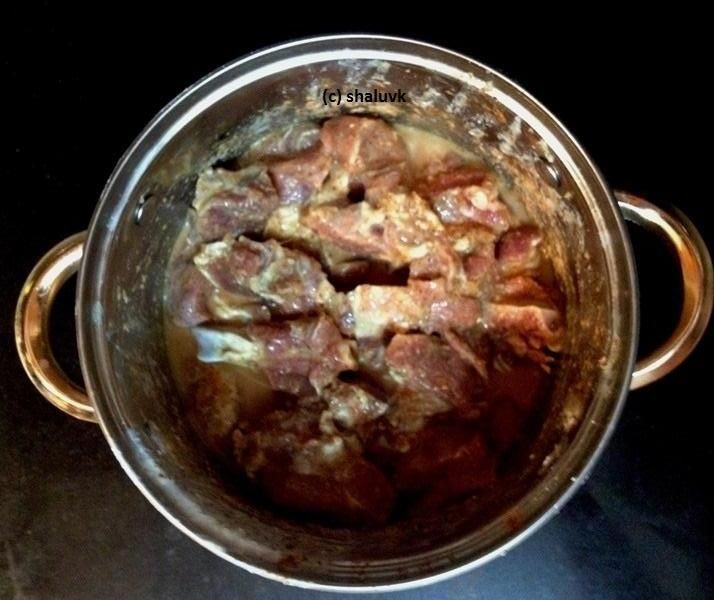
The marinade ready to bung into the refrigerator.
Next, added about 3 tbsp of clarified butter/ghee in my trusty pressure cooker and when it was hot, I added a tsp of cumin seeds and fried those. Popped in the mutton and cooked at high heat x 10 minutes.
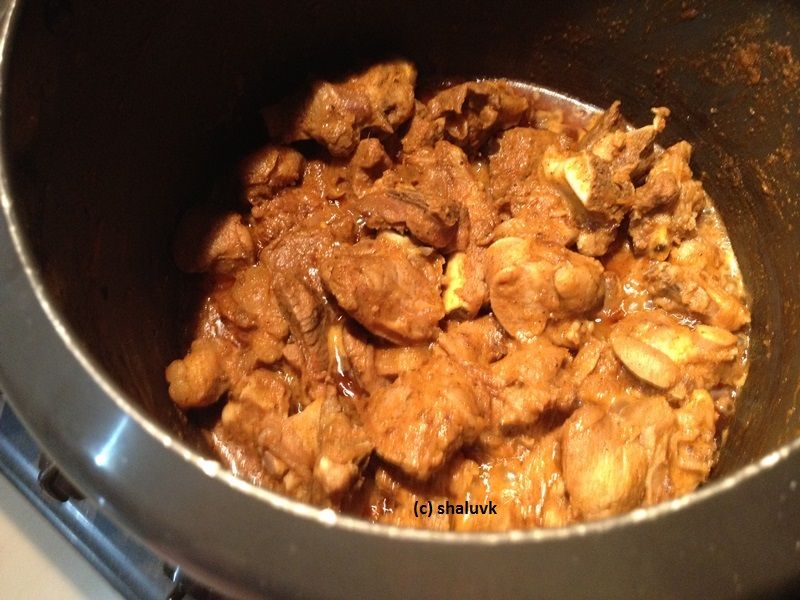
Next, I added 2 roughly diced tomatoes and a handful of spring onions and slow roasted the meat until the ghee left the sides of the cooker (roughly 1/2 hour.) I poured in 2 cups of water and steamed the meat (the usual autoclave settings apply to my pressure cooker too: time: 20 minutes, temperature: 121C and pressure: 15-17 psi.) Voila! Sterile meat!
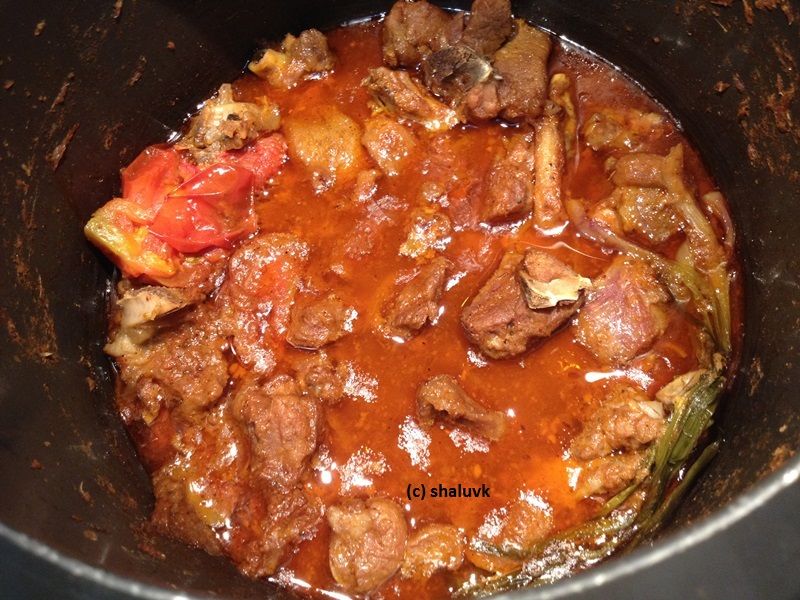
The steamed mutton.
Next I got ready to par-boil my rice. I opted for long grain Basmati rice that I washed some five times in cold water before it was totally free of starch. This recipe has no khada masala (intact spices that you remove from your plate before eating) so you tie a pocket of the spices in cheese-cloth to make what is termed a potli. I just love that word. Muaah.
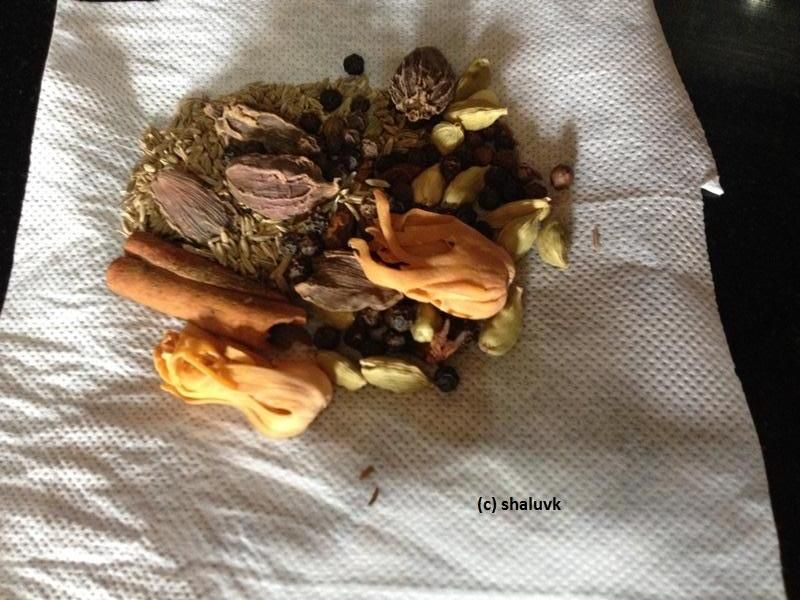
The potli ready for tying. Take approximate measures/numbers of mace, black pepper corns, cardamoms, black cardamoms, white cumin, black cumin, coriander seeds and aniseed to tie a potli the size of a small fist.
I took free volume of water to boil my rice in, added another tbsp of ghee, some ginger and garlic whole, the potli and salt and red chili powder to taste and boiled the rice until it was 3/4 cooked.
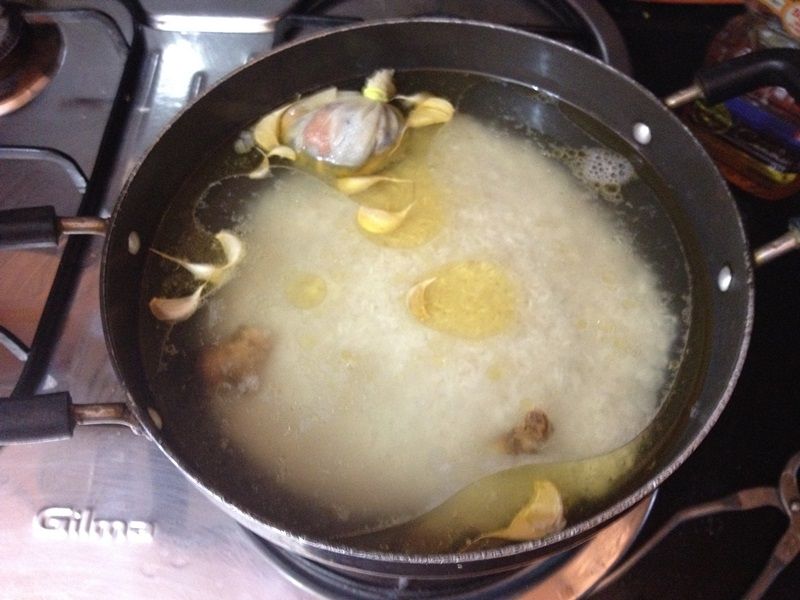
Once the rice was done, I drained it in a colander and discarded the ginger, garlic and the potli. The rice tasted sublime already.
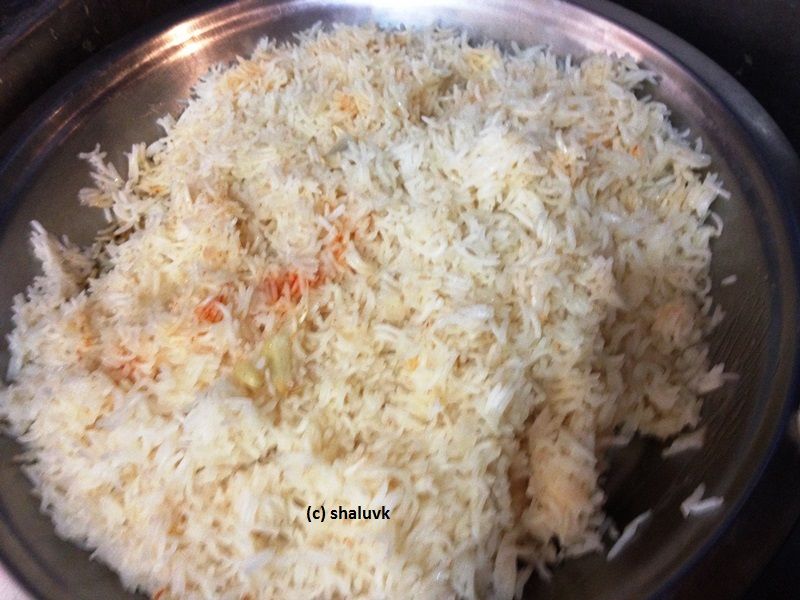
Next I got ready to fry the barista or the crispy fried browned onion (I used 2 medium sized red onions for this) you pack into the biryani. Deep fry in a good volume of oil so that the onion is totally submerged. Fry in small batches else the onion comes out soggy and limp.

The barista.
Next, I soaked some roasted vermicelli and cooked rice in a cup full of warm milk containing saffron. This lends a rich colour to the mix. Also, textures.
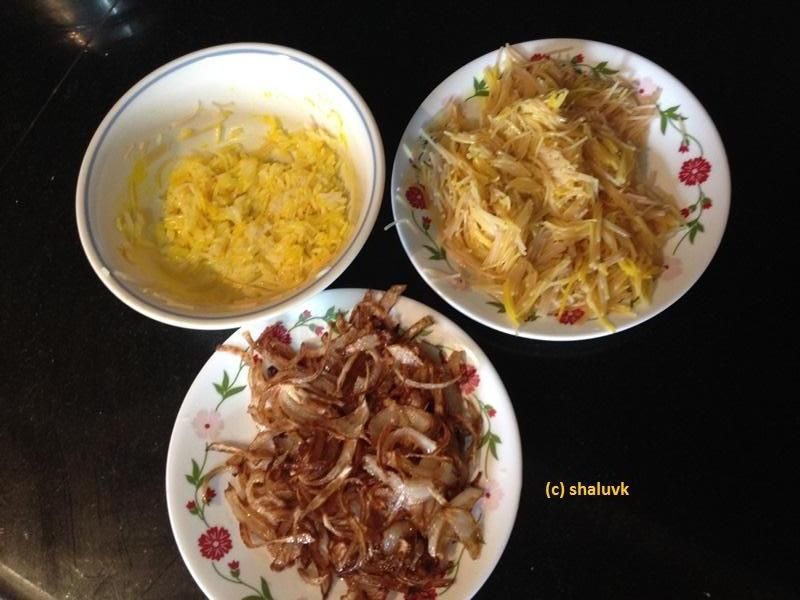
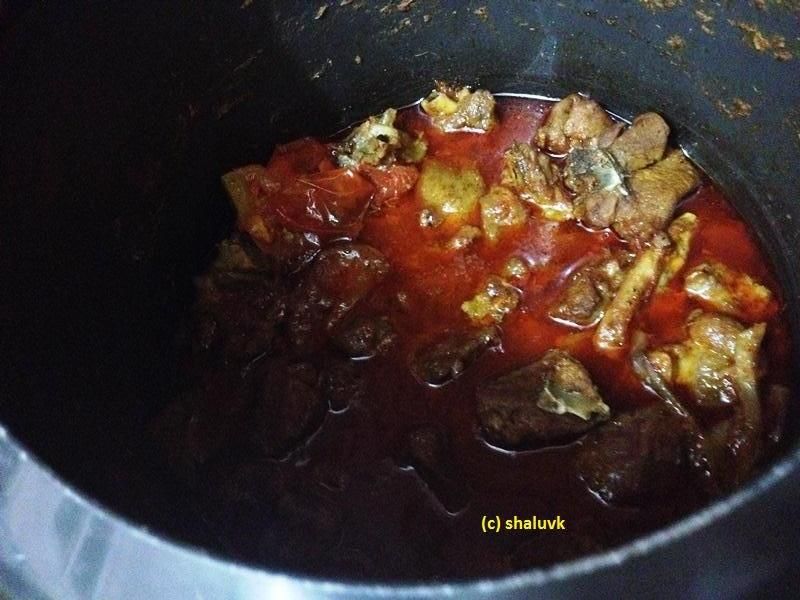
The mutton which had been cooking on low heat until just about a cup ful of jus remained was now ready. I was ready to start arranging my biryani in tiers for the final dum pukht rest.
I took a heavy bottomed pan, added another tbsp of ghee (I've lost count of those *giggles*) and loosely packed a two inch layer of the fragrant rice. Added a few drops of the milk and saffron mix and then a layer of the barista.
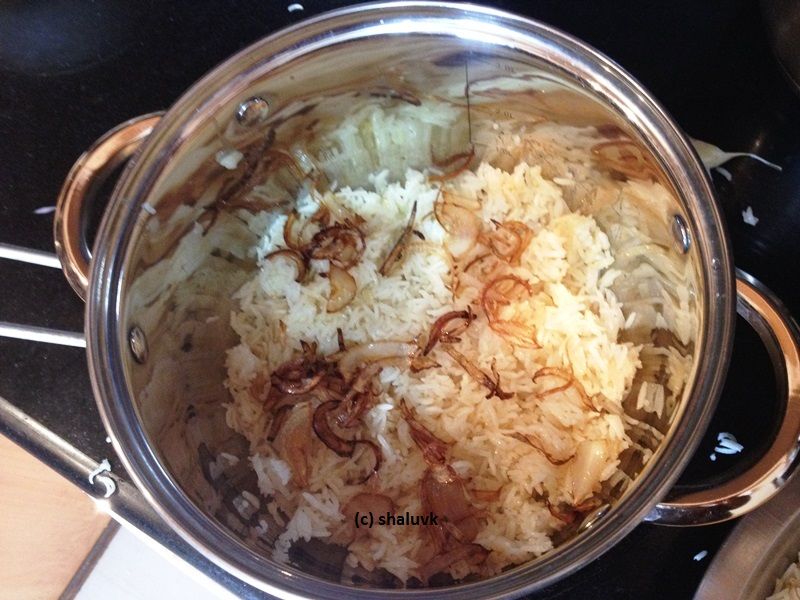
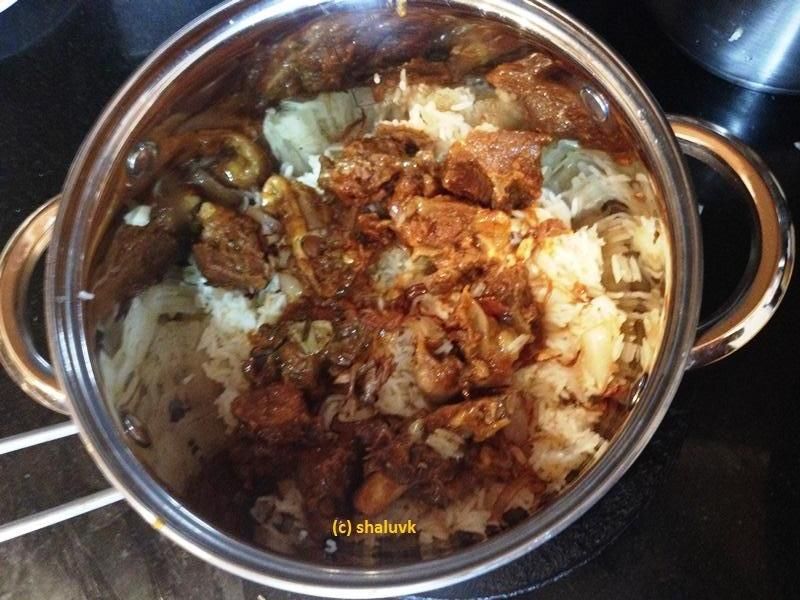
Layer two was a generous dumping of the succulent mutton with its jus.
Repeated tiers of rice, barista and meat so that the final layer was one of rice garnished with the barista. Poured in the remaining warm milk and saffron. You could garnish with finely chopped coriander leaves (also adding mint/pudina imparts a lovely flavour and colour that is missing in this recipe.)
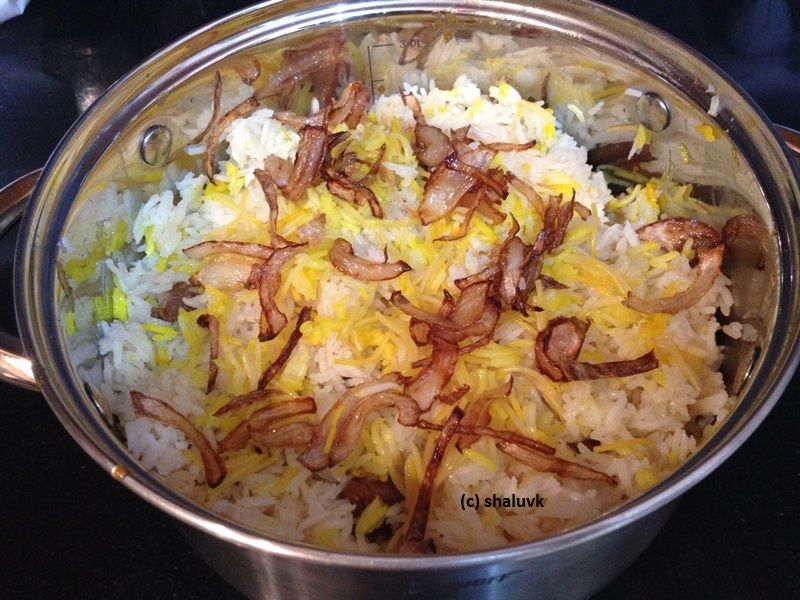
The biryani was ready. You could use an airtight lid/or roll out a thick roti out of wheat dough and seal your container with that and allow it to rest in its own heat x 10 minutes. Alternatively, if you've taken too much time to arrange the tiers so that the biryani is now cool, heat a skillet over low heat and place your container over it x 10 minutes. Serve biryani with the raita of your choice.
Dad, you'd have approved of the intrepid ninja I now am in the kitchen. Also, I make fresh rotis each day and love it too.
I started with a kilogram of fresh cut cabrito/capretto meat from the local butcher and had him chop it into bite sized pieces (about 1.5") for me. These I marinated in a mix of 1 cup hung curd (I cup = 236 ml) + 6 tbsp of fresh ginger garlic paste + 1 tbsp lemon juice + 1 tbsp raw papaya paste (optional) + fresh roasted garam masala + 1 tsp each of red chilli powder, coriander powder, black pepper and salt to taste. You place a lid/wrap good in saran wrap and put away in the refrigerator o/n or at least x 3 hrs.

The marinade ready to bung into the refrigerator.
Next, added about 3 tbsp of clarified butter/ghee in my trusty pressure cooker and when it was hot, I added a tsp of cumin seeds and fried those. Popped in the mutton and cooked at high heat x 10 minutes.

Next, I added 2 roughly diced tomatoes and a handful of spring onions and slow roasted the meat until the ghee left the sides of the cooker (roughly 1/2 hour.) I poured in 2 cups of water and steamed the meat (the usual autoclave settings apply to my pressure cooker too: time: 20 minutes, temperature: 121C and pressure: 15-17 psi.) Voila! Sterile meat!

The steamed mutton.
Next I got ready to par-boil my rice. I opted for long grain Basmati rice that I washed some five times in cold water before it was totally free of starch. This recipe has no khada masala (intact spices that you remove from your plate before eating) so you tie a pocket of the spices in cheese-cloth to make what is termed a potli. I just love that word. Muaah.

The potli ready for tying. Take approximate measures/numbers of mace, black pepper corns, cardamoms, black cardamoms, white cumin, black cumin, coriander seeds and aniseed to tie a potli the size of a small fist.
I took free volume of water to boil my rice in, added another tbsp of ghee, some ginger and garlic whole, the potli and salt and red chili powder to taste and boiled the rice until it was 3/4 cooked.

Once the rice was done, I drained it in a colander and discarded the ginger, garlic and the potli. The rice tasted sublime already.

Next I got ready to fry the barista or the crispy fried browned onion (I used 2 medium sized red onions for this) you pack into the biryani. Deep fry in a good volume of oil so that the onion is totally submerged. Fry in small batches else the onion comes out soggy and limp.

The barista.
Next, I soaked some roasted vermicelli and cooked rice in a cup full of warm milk containing saffron. This lends a rich colour to the mix. Also, textures.


The mutton which had been cooking on low heat until just about a cup ful of jus remained was now ready. I was ready to start arranging my biryani in tiers for the final dum pukht rest.
I took a heavy bottomed pan, added another tbsp of ghee (I've lost count of those *giggles*) and loosely packed a two inch layer of the fragrant rice. Added a few drops of the milk and saffron mix and then a layer of the barista.


Layer two was a generous dumping of the succulent mutton with its jus.
Repeated tiers of rice, barista and meat so that the final layer was one of rice garnished with the barista. Poured in the remaining warm milk and saffron. You could garnish with finely chopped coriander leaves (also adding mint/pudina imparts a lovely flavour and colour that is missing in this recipe.)

The biryani was ready. You could use an airtight lid/or roll out a thick roti out of wheat dough and seal your container with that and allow it to rest in its own heat x 10 minutes. Alternatively, if you've taken too much time to arrange the tiers so that the biryani is now cool, heat a skillet over low heat and place your container over it x 10 minutes. Serve biryani with the raita of your choice.
Dad, you'd have approved of the intrepid ninja I now am in the kitchen. Also, I make fresh rotis each day and love it too.